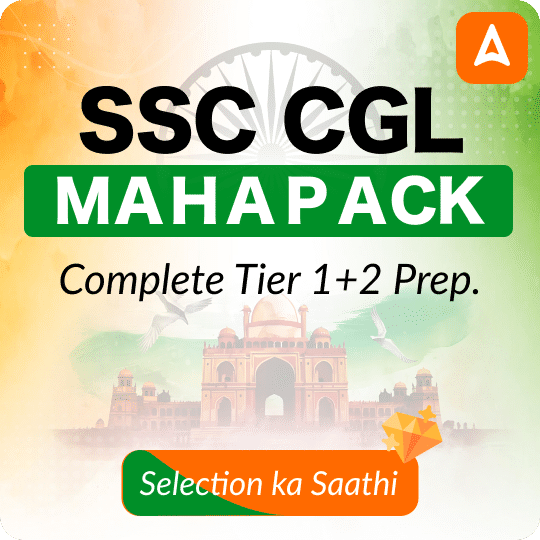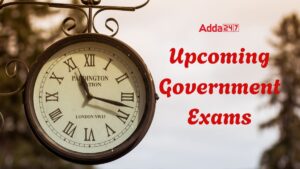Active and Passive voice for SSC-CGL
Active and Passive voice: There are two ways to convey sentences in English: Active voice and Passive voice. While the object of the activity is highlighted in passive voice, the subject executing the action is highlighted in active voice. For competitive tests like the SSC CGL, understanding the difference between the active and passive voice is essential. Let’s explore the definition, categories, usage guidelines, illustrations, and exercises for active and passive voice.
What is Voice of Verb?
The voice of verb – The voice of a verb refers to the form or structure of a verb that indicates whether the subject of the sentence is performing the action (active voice) or receiving the action (passive voice). It determines the relationship between the subject and the verb in a sentence.
In English grammar, There are two voices of verb:
1 – Active Voice
2 – Passive Voice
Active and Passive Voice: Definition
The candidates who are preparing English Grammar for various government exams should be aware of the definitions for the terms active voice and passive voice. Knowing these definitions will help them find logic in the syntax of the sentences and arrive at the current answer from the options provided in the exam. The candidates can refer to the definitions and explanations provided below for more information.
Active Voice: In active voice, the subject performs the action mentioned in the sentence. It emphasizes the doer of the action.
- In an active voice, the subject of a sentence performs the action.
- The subject is the doer or the agent of the action.
- Active voice is straightforward, direct, and often used in everyday communication.
- It highlights the person or thing responsible for the action.
- Active voice sentences typically follow a subject-verb-object (SVO) structure.
- Active voice is commonly used to express facts, commands, instructions, or personal experiences.
Example – Active Voice: “John (subject) eats (verb) an apple (object).” In this sentence, the subject “John” performs the action of “eating” the object “an apple.”
Passive Voice: In passive voice, the subject receives the action mentioned in the sentence. It emphasizes the object or receiver of the action.
- In passive voice, the subject of a sentence receives the action.
- The subject becomes the receiver or the object of the action.
- Passive voice is often used when the focus is on the action itself or when the doer is unknown, unimportant, or intentionally omitted.
- It places emphasis on the object or the result of the action.
- Passive voice sentences typically follow an object-verb-subject (OVS) structure.
- Passive voice is commonly used in formal writing, scientific reports, or when the doer is irrelevant or known.
Example – Passive Voice: “The apple (subject) is eaten (verb) by John (agent/doer).” In this sentence, the subject “the apple” is receiving the action of being “eaten,” and the doer “John” is mentioned using the preposition “by.”
It’s important to note that while active voice is generally preferred for its clarity and directness, there are instances where passive voice may be more appropriate or necessary. Understanding the context and purpose of the sentence will help in deciding which voice to use.
Active and Passive Voice: 7 Types with Examples for SSC CGL
The topic of Active and Passive voice is one of th most repeated concepts asked in the Tier 1 as well as Tier 2 stages of the selection process. The questions in the exam are asked under various tenses according to which the syntax as well as the rules vary. These questions can be categorized into seven types which are mentioned below along with some previous year questions as examples.
- Simple Present Tense
- Simple Past Tense
- Present Continuous Tense
- Past Continuous Tense
- Present Perfect Tense
- Past Perfect Tense
- Future Tense
Let’s delve deeper into the various active and passive voice forms:
- Simple Present Tense:
Active Voice: In simple present tense, the subject performs an action that is habitual, regular, or a general truth. Example: “She writes a letter.”
Passive Voice: The passive form of the simple present tense is formed using the auxiliary verb “is/are” + past participle of the main verb. Example: “A letter is written by her.”
- Simple Past Tense:
Active Voice: In simple past tense, the subject performed an action in the past. Example: “They built a new bridge.”
Passive Voice: The passive form of the simple past tense is formed using the auxiliary verb “was/were” + past participle of the main verb. Example: “A new bridge was built by them.”
- Present Continuous Tense:
Active Voice: In present continuous tense, the subject is currently performing an ongoing action. Example: “He is writing an interesting novel.”
Passive Voice: The passive form of the present continuous tense is formed using the auxiliary verb “is/are being” + past participle of the main verb. Example: “An interesting novel is being written by him.”
- Past Continuous Tense:
Active Voice: In past continuous tense, the subject was engaged in a continuous action in the past. Example: “She was studying for the exam.”
Passive Voice: The passive form of the past continuous tense is formed using the auxiliary verb “was/were being” + past participle of the main verb. Example: “The exam was being studied for by her.”
- Present Perfect Tense:
Active Voice: In present perfect tense, the subject has completed an action with relevance to the present. Example: “They have finished their work.”
Passive Voice: The passive form of the present perfect tense is formed using the auxiliary verb “has/have been” + past participle of the main verb. Example: “Their work has been finished by them.”
- Past Perfect Tense:
Active Voice: In past perfect tense, the subject had completed an action before another past event. Example: “He had completed the assignment before the deadline.”
Passive Voice: The passive form of the past perfect tense is formed using the auxiliary verb “had been” + past participle of the main verb. Example: “The assignment had been completed by him before the deadline.”
- Future Tense:
Active Voice: In future tense, the subject will perform an action in the future. Example: “She will attend the meeting tomorrow.”
Passive Voice: The passive form of the future tense is formed using the auxiliary verb “will be” + past participle of the main verb. Example: “The meeting will be attended by her tomorrow.”
Understanding the different types of active and passive voice in various tenses will help you construct sentences effectively and convey the intended meaning.
Active and Passive Voice: Rules for SSC CGL
Here are the rules for converting sentences from active voice to passive voice:
- Identify the subject, verb, and object:
- In active voice, the subject performs the action, the verb shows the action, and the object receives the action.
- Example: “She writes a letter.” (Subject: She, Verb: writes, Object: a letter)’
- Change the object to the subject in the passive voice sentence:
- The object of the active voice becomes the subject of the passive voice.
- Example: “A letter is written by her.”
- Change the verb from active to passive form:
- The verb in the active voice is changed to its corresponding form in the passive voice.
- Add the appropriate form of the auxiliary verb “be” (is, am, are, was, were) and the past participle of the main verb.
- Example: “A letter is written by her.” (Active: writes -> Passive: is written)
- Include the preposition “by” to indicate the doer of the action:
- In the passive voice, the subject is introduced by the preposition “by” to show who performed the action (optional if not important or unknown).
- Example: “A letter is written by her.”
- Maintain the tense of the sentence:
- The tense of the sentence remains the same in both active and passive voice.
- Example: “She writes a letter.” (Active voice, Present Simple) -> “A letter is written by her.” (Passive voice, Present Simple)
- Keep in mind the subject-verb agreement:
- The verb in the passive voice must agree with the subject.
- Example: “He opens the door.” (Active voice, Present Simple) -> “The door is opened by him.” (Passive voice, Present Simple)
Note – It’s important to know that not all sentences can or should be converted to the passive voice. The decision to use active or passive voice depends on the context and emphasis of the sentence.
Active and Passive Voice for SSC- CGL PDF
Let’s investigate The foundations of active passive voice are crucial for you to master if you want to work in the banking or government sectors. You will need to employ active and passive voice effectively for formal communication at work in addition to the fact that it is a crucial component of grammar in all banking and government exams. Here is the link to the pdf with a lot of help you ease through it.
Active and Passive voice Quiz for SSC-CGL
Instructions:
Choose the correct form (active or passive voice) for each sentence. Select the letter corresponding to your chosen answer. At the end of the quiz, you will find the correct answers.
1.Mona was writing a letter to her father-
- A letter was written to her father by Mona
- A letter has been written to her father by Mona
- A letter was being written by Mona to her father
- A letter was written by Mona to her father.
2.He teaches us Grammar-
- Grammar is taught to us by him.
- We are being taught Grammar by him
- Grammar is being taught us by him
- We are taught Grammar by him
3.Do you imitate others?
- Have others been imitated by you?
- Were others being imitated by you?
- Are others being imitated by you?
- Are others imitated by you?
4.I saw him conducting the rehearsal-
- He was seen conducting the rehearsal
- I saw the rehearsal being conducted by him
- He was seen by me to conduct the rehearsal
- I saw the rehearsal to be conducted by him
5.His pocket has been picked-
- They have his pocket picked
- Picking has been done to his picked
- Picked has been his pocket
- Someone has picked his pocket
6.The French surrendered Quebec to the English in 1759-
- Quebec was surrendered by the French to the English in 1759
- Quebec was surrendered to the English in 1759 by the French
- The English were surrendered Quebec in 1759 by the French
- Quebec was surrendered in 1759 by the French to the English
7.A stone struck me on the head-
- My head was struck by a stone
- I was struck by a stone on the head
- I had been struck by a stone on the head
- I was struck on the head by a stone
8.My uncle promised me a present-
- I was promised by my uncle a present
- I had been promised a present by my uncle
- I was promised a present by my uncle
- A present was promised by my uncle to me
9.Please help me-
- You were requested to help me
- You are being requested to help me
- You are requested to help me
- You have been requested to help me
10.Who is creating this mess?
- Who has created mess
- By whom this mess is being created
- By whom has this mess been created
- By whom is this mess being created
Answer Key:
- C
- D
- D
- A
- D
- B
- D
- C
- C
- D
Active and Passive voice for SSC-CGL Tier II PDF
For the SSC-CGL Tier II, Active and Passive voice for SSC-CGL exam, knowing the difference between active and passive voice is essential because questions about phrase transformation, error detection, and sentence improvement frequently call for this knowledge.
Active and Passive voice for SSC-CGL Tier II PDF – Click here to download
Active and Passive voice Exercise for SSC-CGL
In the following passage there are blanks, each of which has been numbered. These numbers are printed below the passage and against each, five words are suggested, one of which fills the blank appropriately. Find out the appropriate word in each case.
Fourteen centuries ago when the world was much younger, the ruler of all India, Rajah Balhait, was …..(1)…. about his people. A new game of dice, called hard, had …(2) the imagination of his subjects, teaching them that chance alone-a-roll of the dice guided the …(3) of men. All who played this game of fortune lost their …(4) in the virtues of courage, prudence, wisdom and hope. It bred a fatalism that was …(5) the spirit of the kingdom.
Raja Balhait commissioned Sissa, an intelligent courtier at his court to find an answer to this …(6) After much …(7) the clever Sissa invented another game. Chaturanga, the exact …(8) of hard, in which the four elements of the Indian army were the key pieces. In the game these pieces-chariots, horses, elephants and foot soldiers-joined with a royal counselor to defend their king and defeat the enemy. Forceful …(9) was demanded of the players? not luck. Chaturanga soon became more popular than hard, and the …(10) to the Kingdom was over
MCQ
Question :1
Choose the correct word which is suitable for the blank 1 ?
- confident
- indifferent
- ignorant
- concerned
- partisan
Question :2
Choose the correct word which is suitable for the blank 2 ?
- enshrined
- activated
- captured
- propelled
- enhanced
Question :3
Choose the correct word which is suitable for the blank 3 ?
- ways
- destiny
- abnormalities
- communities
- groups
Question :4
Choose the correct word which is suitable for the blank 4 ?
- interest
- wealth
- peace
- bravado
- faith
Question :5
Choose the correct word which is suitable for the blank 5 ?
- crushing
- promoting
- moistening
- appalling
- overwhelming
Question :6
Choose the correct word which is suitable for the blank 6 ?
- risk
- game
- problem
- apprehension
- destiny
Question :7
Choose the correct word which is suitable for the blank 7 ?
- absorption
- hesitation
- insight
- deliberation
- reluctance
Question :8
Choose the correct word which is suitable for the blank 8 ?
- equivalent
- opposite
- picture
- nature
- replica
Question :9
Choose the correct word which is suitable for the blank 9 ?
- concentration
- attack
- manipulation
- prediction
- fortune
Question :10
Choose the correct word which is suitable for the blank 10 ?
- anxiety
- nuisance
- impeachment
- devastation
- threat
Answer Key
- D
- C
- B
- A
- E
- E
- D
- B
- A
- E




 Upcoming Government Exams, Complete Govt...
Upcoming Government Exams, Complete Govt...
 SSC Exam Calendar 2025–26 Out, Check All...
SSC Exam Calendar 2025–26 Out, Check All...
 RRB JE 2024 Notification, CBT 2 Exam Dat...
RRB JE 2024 Notification, CBT 2 Exam Dat...


